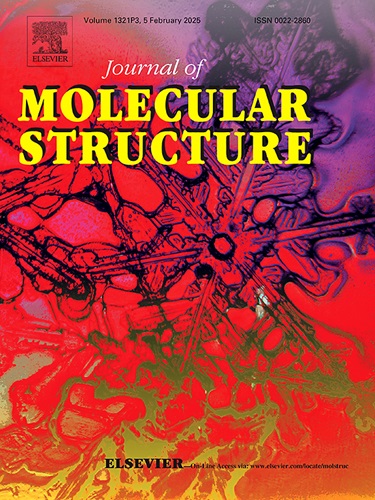Synthesis and characterization of novel pyrazoline derivatives as dual α-amylase /α-glucosidase inhibitors: molecular modeling and kinetic study
IF 4
2区 化学
Q2 CHEMISTRY, PHYSICAL
引用次数: 0
Abstract
Different series of novel tri-substituted pyrazoline derivatives were designed, synthesized, and evaluated for their inhibitory effect against α-glucosidase and α-amylase. All the evaluated compounds showed fluctuating effects against both α-glucosidase and α-amylase with IC50= 170.7 ± 5.24 to 2704.0 ± 2.32 uM and 60.37 ± 3.55 to 353.70 ± 3.95 uM as compared to standard acarbose (IC50 = 558.0 ± 6.83 uM) and (IC50 = 90.54 ± 5.11 uM), respectively. Obviously, compound 10 presented the strongest inhibitory activities among all evaluated compounds. It showed approximately 3-fold and 1.5-fold more potent against α-glucosidase and α-amylase, respectively, than standard. Interestingly, kinetic studies were performed for compound 10 to determine the target inhibiting mode. Furthermore, molecular modeling and ADME properties were also scrutinized to predict the binding mode of compound 10 and prove its stability in the enzymes binding pockets.
新型吡唑啉衍生物α-淀粉酶/α-葡萄糖苷酶双抑制剂的合成与表征:分子模拟与动力学研究
设计、合成了不同系列的新型三取代吡唑啉衍生物,并对其α-葡萄糖苷酶和α-淀粉酶的抑制作用进行了评价。与标准阿卡波糖(IC50 = 558.0±6.83 uM)和(IC50 = 90.54±5.11 uM)相比,所有化合物对α-葡萄糖苷酶和α-淀粉酶的IC50分别为170.7±5.24 ~ 2704.0±2.32 uM和60.37±3.55 ~ 353.70±3.95 uM,表现出波动效应。显然,化合物10的抑制活性最强。对α-葡萄糖苷酶和α-淀粉酶的抑制作用分别比对照品高约3倍和1.5倍。有趣的是,对化合物10进行了动力学研究,以确定目标抑制模式。此外,还通过分子模型和ADME特性来预测化合物10的结合模式,并证明其在酶结合口袋中的稳定性。
本文章由计算机程序翻译,如有差异,请以英文原文为准。
求助全文
约1分钟内获得全文
求助全文
来源期刊

Journal of Molecular Structure
化学-物理化学
CiteScore
7.10
自引率
15.80%
发文量
2384
审稿时长
45 days
期刊介绍:
The Journal of Molecular Structure is dedicated to the publication of full-length articles and review papers, providing important new structural information on all types of chemical species including:
• Stable and unstable molecules in all types of environments (vapour, molecular beam, liquid, solution, liquid crystal, solid state, matrix-isolated, surface-absorbed etc.)
• Chemical intermediates
• Molecules in excited states
• Biological molecules
• Polymers.
The methods used may include any combination of spectroscopic and non-spectroscopic techniques, for example:
• Infrared spectroscopy (mid, far, near)
• Raman spectroscopy and non-linear Raman methods (CARS, etc.)
• Electronic absorption spectroscopy
• Optical rotatory dispersion and circular dichroism
• Fluorescence and phosphorescence techniques
• Electron spectroscopies (PES, XPS), EXAFS, etc.
• Microwave spectroscopy
• Electron diffraction
• NMR and ESR spectroscopies
• Mössbauer spectroscopy
• X-ray crystallography
• Charge Density Analyses
• Computational Studies (supplementing experimental methods)
We encourage publications combining theoretical and experimental approaches. The structural insights gained by the studies should be correlated with the properties, activity and/ or reactivity of the molecule under investigation and the relevance of this molecule and its implications should be discussed.
 求助内容:
求助内容: 应助结果提醒方式:
应助结果提醒方式:


